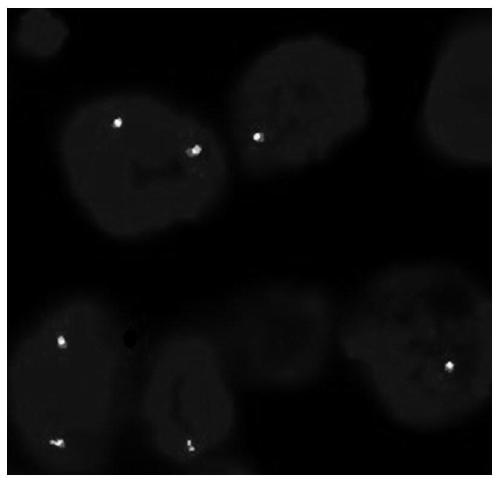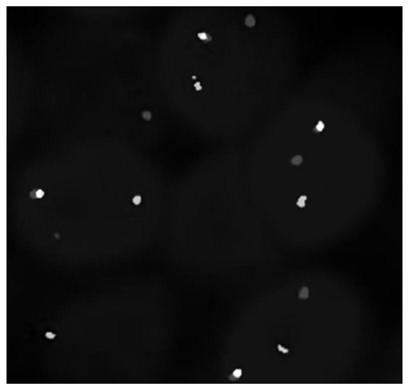FISH probe set for detecting FGFR2 fusion and application thereof
A probe group and probe technology, applied in the direction of recombinant DNA technology, microbial measurement/testing, DNA/RNA fragments, etc., to achieve high specificity and sensitivity, reduce drug side effects, and ingeniously designed effects
- Summary
- Abstract
- Description
- Claims
- Application Information
AI Technical Summary
Problems solved by technology
Method used
Image
Examples
Embodiment 1
[0030] The FGFR2 5' end probe set used two BAC clones (RP11-78A18 and RP11-436E17) as templates, and the 3' end probe set used two BAC clones (RP11-7P17 and RP11-984I17) as templates, and the above BAC clones were all Purchased from Oakland Children's Hospital Research Institute, USA. The fabrication and labeling steps of the probe set are as follows:
[0031] (1) In two 200 μL PCR reaction tubes, add the reaction materials according to the following system to prepare and label the 5′-end probe set and the 3’-end probe set:
[0032]
[0033]
[0034] The above random primers consist of 9 nucleotides, each nucleotide is A, T, C or G, and the first and / or fifth nucleotides from the 5' end are modified with fluorescence through spacer9 connection group; the formula of the above 5×Buffer is: 10mM Tris-HCl, 25mM MgCl 2 (magnesium chloride), with ddH 2 O preparation.
[0035] After mixing by pipetting, denature at 95°C for 10 minutes on a PCR instrument, immediately place ...
Embodiment 2
[0049] The steps of using a UV spectrophotometer to measure the labeling efficiency and concentration of the probes in the above-mentioned probe group are as follows:
[0050] (1) Turn on the UV spectrophotometer (NanoDrop), select the full-wavelength mode, and select the corresponding wavelength. After blank calibration, measure the A of the 5′-end probe group respectively. 260nm 、A Dye (FITC:A 494nm ) and A of the 3′ end probe set 260nm 、A Dyc (Tetramethyl-rhodamine: A 560nm ).
[0051] (2) Since the fluorescent dye also has a certain absorbance value at 260nm, in order to make the absorbance value of the probe at 260nm more accurate, use the following formula to correct A 260 Value: A Base =A 260 -(A Dye ×CF 260 ), CF 260 Refers to the correction factor, which is a constant, and each fluorescent dye has a certain CF 260 Values, such as the CF of Tetramethyl-rhodamine 260 The value is 0.06 and FITC is 0.32. (3) Calculate the probe labeling efficiency and concent...
Embodiment 3
[0056] The FGFR2 gene breakage probe system prepared in Example 1 was used to detect 50 intrahepatic cholangiocarcinoma samples with known FGFR2 gene fusion results provided by the hospital, and the detection steps were as follows:
[0057] (1) Sample dewaxing and rehydration: immerse tissue section samples in 3 tanks of xylene for 10 minutes each time for dewaxing, and then soak in 100%, 100%, 100%, 85% and 70% ethanol for 3 minutes, Finally, immerse in deionized water for 3 min.
[0058] (2) Sample pretreatment and digestion: Boil the tissue section sample in 100°C water for 20 minutes, take out the sample and digest it with pepsin for 10 minutes, transfer it to 2×SSC solution for 3 minutes, take out the sample and immerse it in 70%, 85% and 100% Ethanol dehydration, 3min each time, take out the sample to dry naturally.
[0059] (3) Hybridization of the sample with the probe: Use a pipette gun to take 10 μL of the FGFR2 gene fragmentation probe system and add it to the samp...
PUM
 Login to View More
Login to View More Abstract
Description
Claims
Application Information
 Login to View More
Login to View More - R&D
- Intellectual Property
- Life Sciences
- Materials
- Tech Scout
- Unparalleled Data Quality
- Higher Quality Content
- 60% Fewer Hallucinations
Browse by: Latest US Patents, China's latest patents, Technical Efficacy Thesaurus, Application Domain, Technology Topic, Popular Technical Reports.
© 2025 PatSnap. All rights reserved.Legal|Privacy policy|Modern Slavery Act Transparency Statement|Sitemap|About US| Contact US: help@patsnap.com



